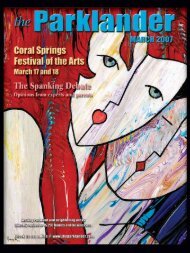February 2008 - The Parklander Magazine
February 2008 - The Parklander Magazine
February 2008 - The Parklander Magazine
- No tags were found...
Create successful ePaper yourself
Turn your PDF publications into a flip-book with our unique Google optimized e-Paper software.
ARTS&ENTERTAINMENTARTWALKSDegas in Bronze:By Yvette Jayson Sencer, Ph.D.Edgar Degas (1834-1917) is well known for hisoil paintings, pastel and charcoal renderings ofballerinas, entertainers, bathers, and racehorses,and for one groundbreaking sculpture of afourteen year old dancer. What is not so wellknown, is that Degas made many small sculpturesthat were never exhibited during his lifetime.<strong>The</strong>se were clay or wax, three-dimensional studiesof figures in motion, which Degas created for hisown personal investigation of expressivegestures, and then discarded in the studiowhen he was finished using them.Edgar Degas, Spanish Danceconceived around 1882-1895, bronzecast in 1920’s and after from wax sculpture.Collections MASP, Museu de Arte de Sao Paulo, Brasil.©2007 Courtesy of International Arts<strong>The</strong> Boca Raton Museum of Art is presenting an exhibition of bronzesculptures by Edgar Degas from January 25 through April 27, <strong>2008</strong>.Degas in Bronze: <strong>The</strong> Complete Sculptures offers museum visitors a rareopportunity to view works that Degas originally crafted for his own personalexpression, not for public display.Numerous small sculptures were found in Degas’ studio after his death.<strong>The</strong>73 sculptures in this exhibition were cast in bronze in order to prevent thefragile clay and wax statuettes from crumbling. A limited edition of fourcomprehensive sets of these works was cast. <strong>The</strong> collection of Degas’bronzes at the Boca Raton Museum is on loan from Brazil’s renownedMuseu de Arte de Sao Paulo.<strong>The</strong> collection is one of the limited edition sets produced in the 1920’s andafter by Hebrard, and cast by Albino Palazzolo, under the supervision ofDegas’ friend Albert Bartholome.bather, or racehorse from every angle. Degas used the statuettes to studyhow the figure functions, and to develop interesting poses for major paintingsand drawings.Among the works featured in this exhibition is Horse at Trough (c.1865-68),cast in bronze from a wax original. <strong>The</strong> horse of the statuette is believed tobe the same horse in Degas’ painting, Mille Fiocre in the Ballet “La Source”,exhibited in the Paris Salon of 1868, and currently in the collection of theBrooklyn Museum in New York.Many figures of dancers are shown, including <strong>The</strong> Spanish Dance, DancerRubbing Her Knee, and Dressed Dancer at Rest, Hands Behind Her Back, RightFoot Forward.<strong>The</strong> one sculpture which Degas did make for public display is Little Dancer,Aged Fourteen. <strong>The</strong> Little Dancer was the result of numerous preliminarystudies in charcoal, pastel, and sculpture.Degas was particularly concerned with the problem of how the movementand gesture of a body may reveal one’s inherent personality. His concernwith the nature of movement led him to make many two dimensional studieson paper, and to also make three dimensional studies in soft, pliablematerials. Two dimensional studies present a single view, while threedimensional studies capture the essence of the muscular action of a dancer,64 FEBRUARY <strong>2008</strong><strong>The</strong> subject is the teenage daughter of a local laundress. Marie VanGoethem was a student at the Ecole de Danse in Paris. Young girls, likeMarie, were called “little rats” by the professional dancers. From an earlyage, they studied and practiced their ballet positions, and yearned to be inthe spotlight at the Paris Opera Ballet. Degas has captured that sense ofyearning in his sculpture of Marie.
















